An Uphill Battle
Fri, July 25, 2025
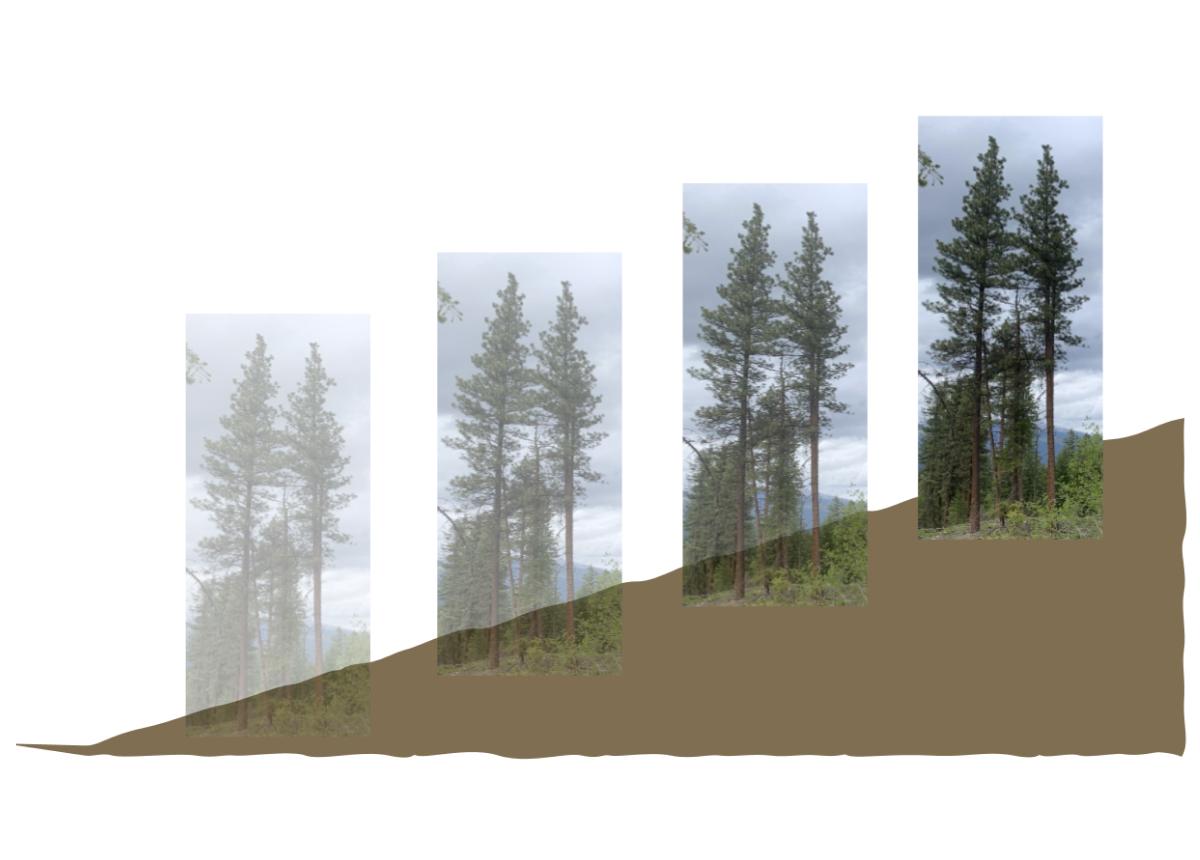
On the west coast of America, one of the major concerns with climate change is water availability. As things get hotter, there is less snowpack on top of the mountains every winter so there is less water to supply our streams, lakes, and faucets in the summers. But what changes in the areas that are not on the tops of mountains?
We took a water-focused approach in examining how climate, and by extension, vegetation, will change with changing climate across King County. We split existing climatic conditions in King County into distinct climate classes. We used four variables to predict the climate classes: summer maximum temperatures and winter minimum temperatures, actual evapotranspiration (AET), and water deficit. AET refers to how much water is leaving a system to enter the atmosphere. There are many ways this can occur: standing water (puddles, etc.) can evaporate, water in soil can evaporate, water on tree leaves can evaporate, and trees take water out of the soil and when they “breathe” they release that water, just like you. The water deficit depends partially on AET. If AET is how much water is actually leaving a system, potential evapotranspiration (PET) is how much water COULD leave a system if there was unlimited water with the same temperatures, sunlight, tree activity, etc. The difference between how much water a system could use under no water stress (PET) and the actual amount of water used (AET) is the water deficit. Higher water deficit means that vegetation experiences more water stress.
We identified four distinct climate classes that currently exist in King County, WA (Figure 1). We named these classes based on their overriding climate conditions. Warm Maritime (W. Mar.) is found in the lowlands (ex. Seattle) and gets a lot of rain in the winter and little precipitation in the summer, but has a lot of clouds year-round. The Cool Rainy class (C. Rainy) is found in the foothills of the Cascades and gets heavy rain, so much so that it less frequently has a water deficit. Cool Snowy (C. Snowy) gets very heavy precipitation, again mostly in the winter, but it gets a mix of rainy and snow whereas Cold Snowy (Cd. Snowy) gets almost all of its precipitation as snow. It gets so much snow that many of these locations have a snowpack that does not fully melt in the winter.
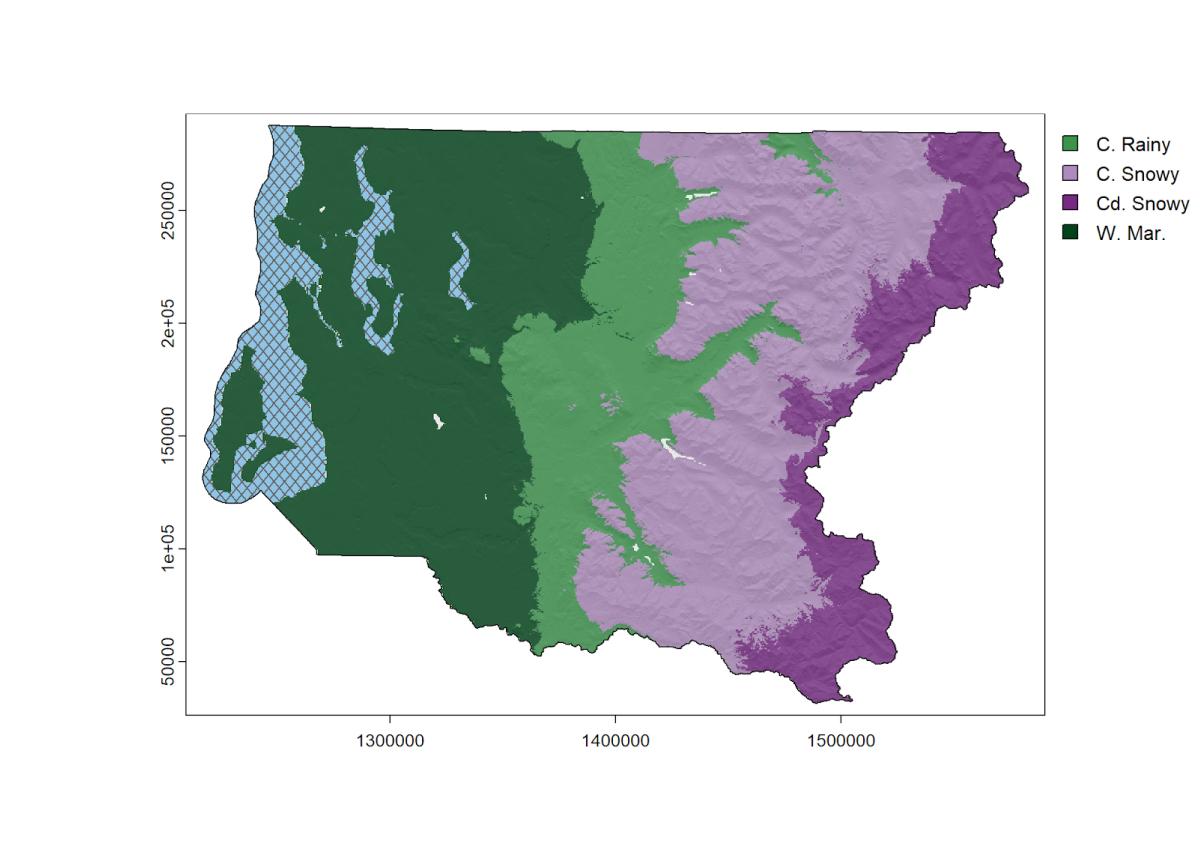
Each climate class has a couple of dominant vegetation communities:
• Warm Maritime
◦ Douglas-fir and western hemlock
◦ Bigleaf maple and red alder
• Cool Rainy
◦ Douglas-fir, western hemlock, and western redcedar
◦ Bigleaf maple and red alder
• Cool Snowy
◦ Douglas-fir, western hemlock, silver fir
◦ Mountain hemlock
◦ Western redcedar and western hemlock
• Cold Snowy
◦ Douglas-fir, western hemlock, silver fir
◦ Mountain hemlock
◦ Treeless, rocky environments
That’s now, but what about what we expect in the future under climate change? We took our same classification system and applied it to modeled future climate data (Figure 2). We tested more than one potential climate future (because the future is, of course, unknown), but there’s only one here for simplicity’s sake. But look, we now see five climate classes! All that means is that in the future, there will be climate conditions in King County, in Seattle and the surrounding lowlands, that don’t currently exist there.
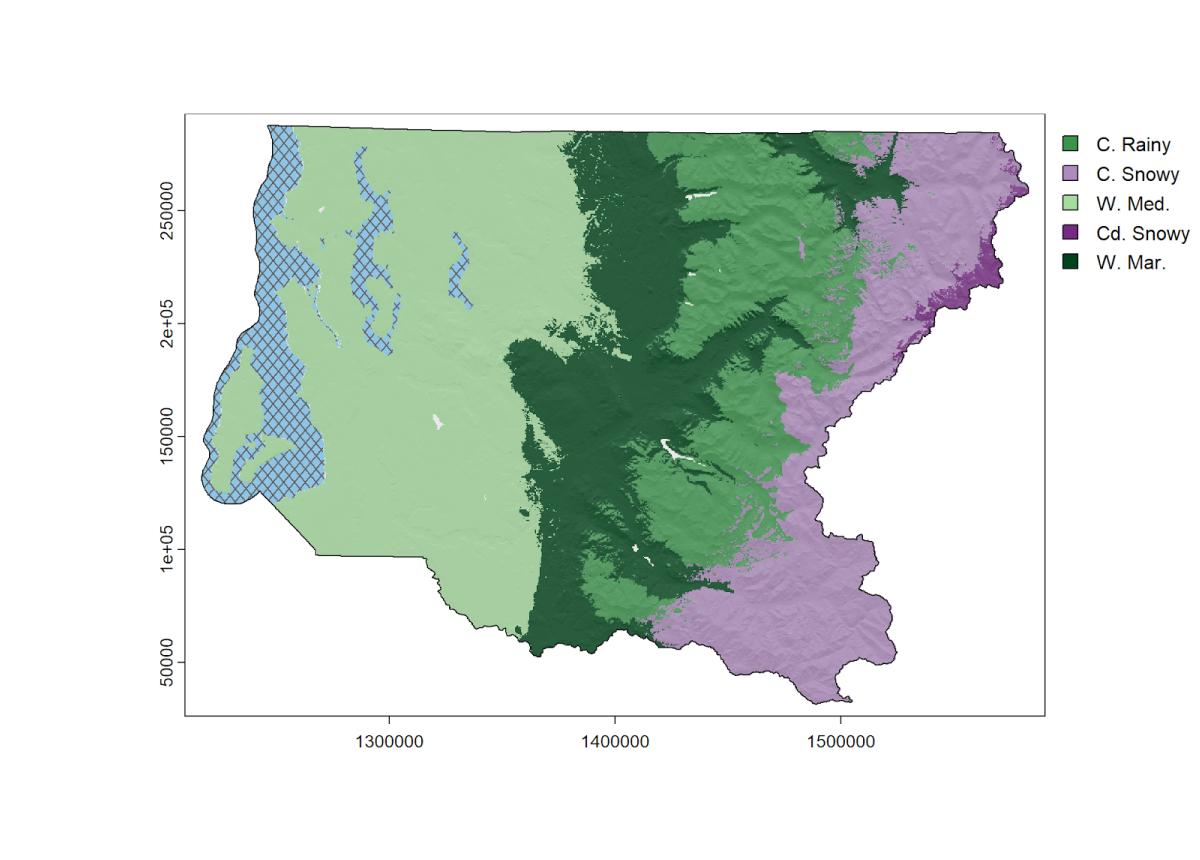
If we don’t know where that class is in current conditions, how do we give it a name and determine what types of vegetation we find there? Well, if it doesn’t exist in King County, maybe it exists outside King County! So that’s exactly what we checked. We applied our same classification system to all of western Washington and found that Vancouver, WA is the only place that the new class (Warm Mediterranean, or W. Med.) exists (Figure 3). This climate class is a little bit warmer and drier than the Warm Maritime climate class. While most of the area within this climate class is currently used for agriculture, the few forested lands are dominated by Douglas-fir and western hemlock.
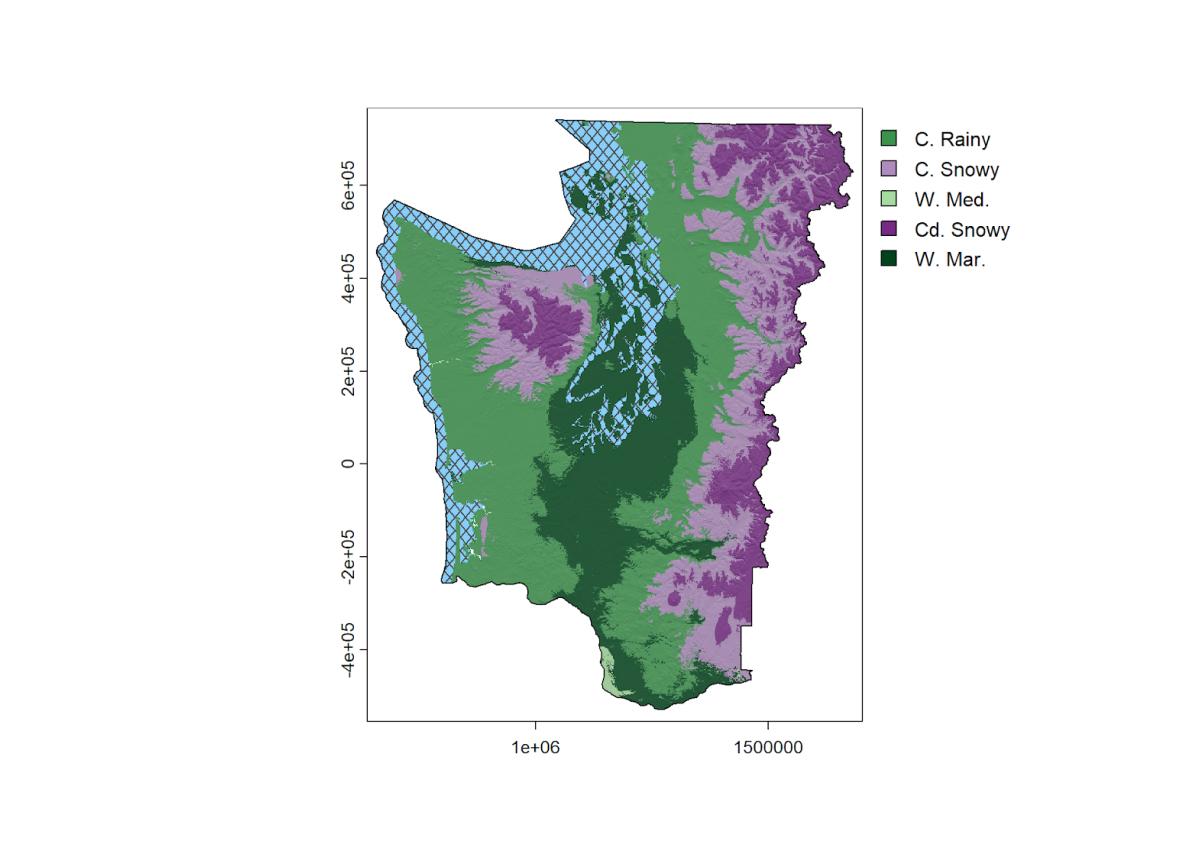
If we compare the current and future King County maps side by side, we can see that the new Warm Mediterranean class takes over the region previously occupied by the Warm Maritime climate class. Similarly, the Warm Maritime class will move into the region currently occupied by the Cool Rainy class. The Cold Snowy class will retreat only to the highest peaks in the Cascades; most of the land area that is currently Cold Snowy will become Cool Snowy. Both these snowy classes will shrink in land area as they run out of high elevation space. This isn’t to say every point that has the Warm Maritime climate will eventually exhibit the Warm Mediterranean climate, but the majority of them probably will.
So what does this mean for the trees? Let’s imagine a single point on the landscape. Say it’s currently in the Cool Snowy class but in the future will have the Cool Rainy climate. The trees can’t move as fast as the climate, so we will have Cool Snowy trees in a Cool Rainy climate. They’ll live, but they won’t be as vigorous as if they were situated in the climate they’re most adapted for. We quantified this by asking, “How far is this future Cool Rainy point to the nearest CURRENT location of the Cool Rainy climate?” If that distance is greater, we assume that the existing forest will be less likely to thrive in the future than if that distance is shorter.
We also wanted to consider similarities in the climate classes. If something is currently the Cool Snowy class and will become the Cool Rainy class, that might not be as big of a climactic change as the Cool Snowy class becoming the Warm Maritime class (we did see some of these changes). We took the same data we used to classify the landscape into climate classes and put them into a process called Non-metric Multi-Dimensional Scaling. This is a very mathy process that takes lots of variables and compresses them into two dimensions called multivariate space. Then you can look at your data in two dimensions and draw conclusions about relative relationships between classes. In our case, if the data for two of the climate classes was far away in “multivariate space”, then we know that those classes are not very similar in the real world and any vegetation that sees this change is likely going to experience a large shock to its system. Similarly, if two classes are very close in multivariate space, then they are likely very similar climate classes and the transition won’t be as jarring for the vegetation.
We multiplied the two metrics (the literal distance and the multivariate distance) for each point on the landscape into one unitless metric of “concern” (Figure 4). Notice that all the highest areas of concern occur in the lowlands. This is the area that will become the class that only currently exists in Vancouver, WA which is much further from King County than any part of King County is from itself. So naturally this region was going to have a much higher distance. But the highest areas of concern are actually in the Cascade foothills where we see the edge of the current Cool Rainy class transition to the Warm Mediterranean class. This transition has a high physical distance and a high multivariate distance, so the existing forest will be less suited to the potential climate in multiple ways.
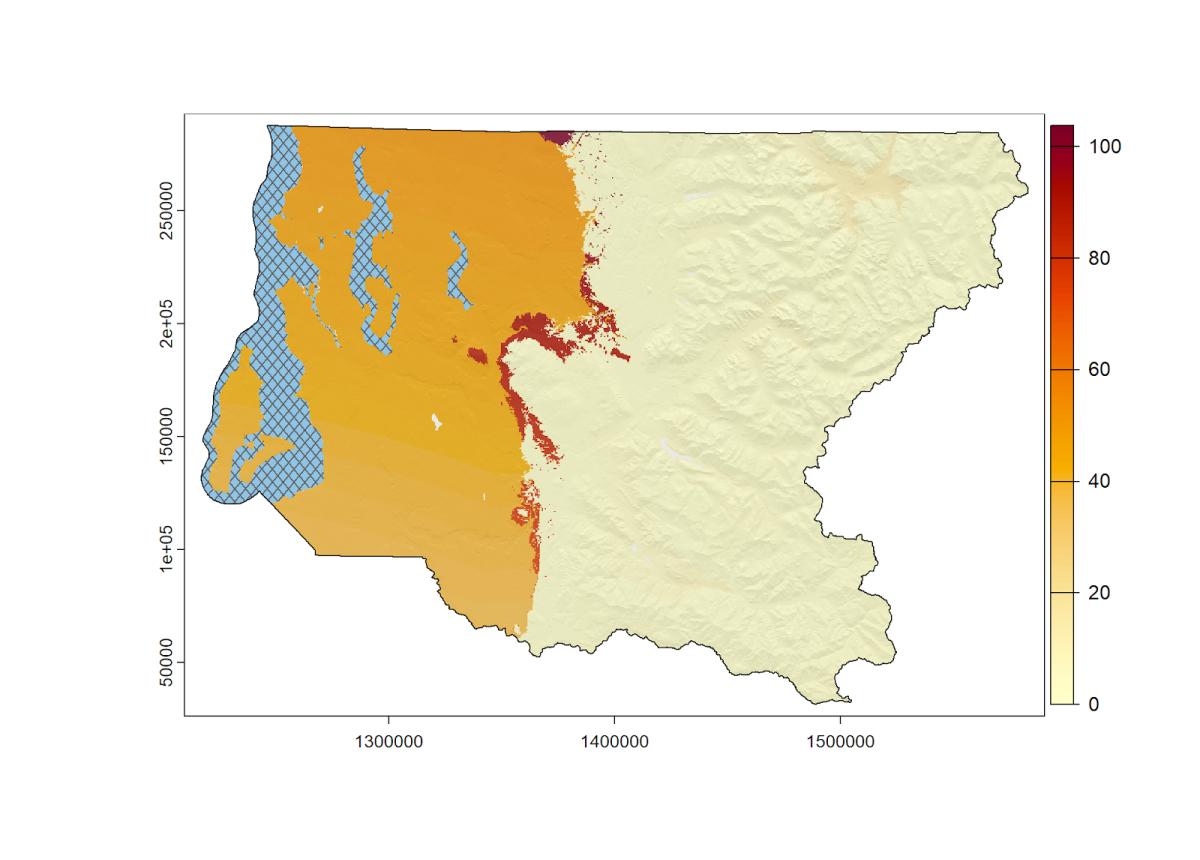
Is there anything we can do about this? Absolutely! Foresters have tools to increase the resilience of a forest. Depending on the transition that a specific point will experience, there are several options. If the forest compositions are similar between the current and future scenarios, then we can evenly thin a forest to reduce water stress but maintain species compositions. If the new climate has a higher likelihood of fire, then, when we thin, we can remove those species that are not likely to thrive in the future climate, if there are any. If the species compositions of the current and future compositions are wildly different then we can plant trees that will be more likely to thrive in the new climate. So yes, things are changing, and the forest of today may not be the forest of the future, but that doesn’t mean there won’t be a forest at all.
